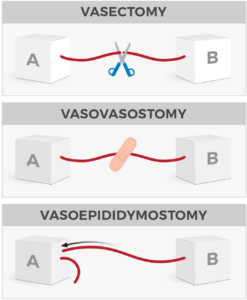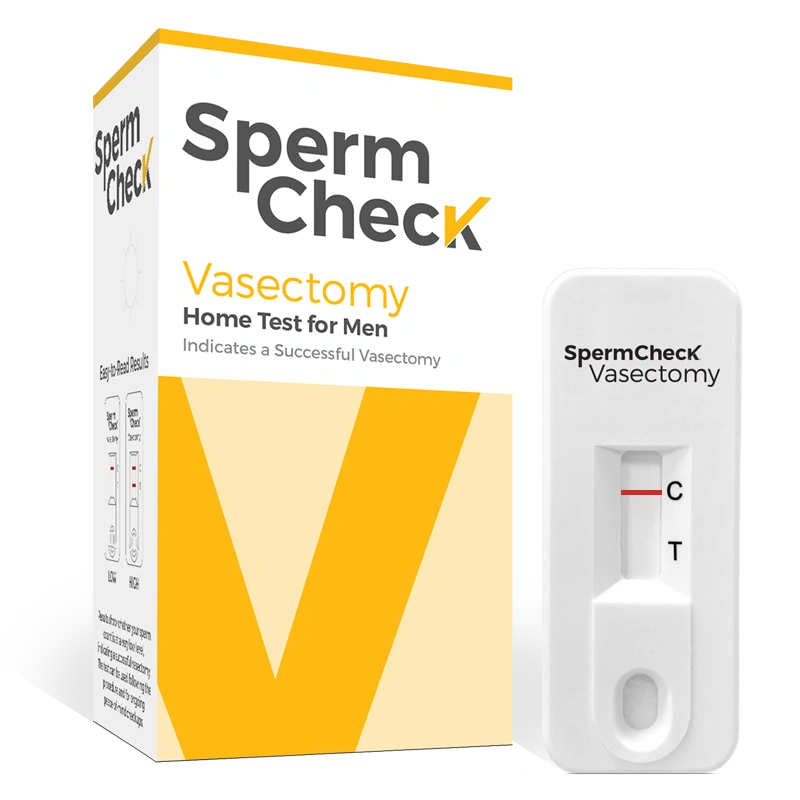
Are you considering having a child or more children and curious about the vasectomy reversal success rate? Ensure you have the knowledge to make the best choice for your life circumstances. This blog will explain the two types of vasectomies, their effectiveness, how a vasectomy reversal works, vasectomy reversal success rates, and more.
Which Type of Vasectomy Procedure Did You Receive?
There are two common kinds of vasectomies:
Standard Vasectomy
For standard vasectomies, a doctor will make a small incision on the testes to access the tiny tubes that carry sperm to the urethra. These tubes are known as the vas deferens. During the procedure, the doctor will either cut or close these tubes so sperm can no longer exit your urethra and cause a pregnancy. Once the vas deferens is cut or closed, the skin is stitched and is left to heal. Recovery time for this procedure is about a week.
No-Scalpel Vasectomy
With the no-scalpel method, a doctor will make a small puncture hole in the skin of the testes rather than an incision. Though this safe procedure is less invasive, the doctor will still have more than enough access to cut or close vas deferens tubes.
The effectiveness of a vasectomy is the same regardless of which procedure you choose. While some recovery benefits come with the no-scalpel method, several factors contribute to many men opting for the standard approach. These factors include cost, doctor preference, personal preference, and more.
How Effective Is a Vasectomy?
The American Pregnancy Association states that a fully-healed vasectomy procedure is more than 99.8% effective in preventing pregnancies.
It is essential to consider the time necessary after the procedure for semen to be completely free of sperm. This timeframe is different for everyone, but it is beneficial to know that it can sometimes take multiple months for your semen to be entirely sperm-free. If you are unsure about your vasectomy’s effectiveness, consider utilizing a SpermCheck Vasectomy Home Follow-Up Test to confirm that everything is in working order.
How Does a Vasectomy Reversal Work?
A vasectomy reversal reconnects the severed vas deferens so that sperm can again be released to the urethra. There are two prominent types of vasectomy reversals, a vasovasostomy and vasoepididymostomy.
Vasovasostomy
Most vasectomy reversals are performed using the vasovasostomy procedure. A vasovasostomy involves the surgeon reconnecting the two ends of the vas deferens. The procedure typically takes around three hours and is performed under general anesthesia. Though many surgeons consider a vasovasostomy to be a relatively straightforward procedure, it can become a challenge if too much scar tissue is present.
Vasoepididymostomy
A vasoepididymostomy is the more complex of the two surgeries and is typically only used if a vasovasostomy is not possible due to extensive scar tissue. With a vasoepididymostomy, a surgeon will connect the severed vas deferens directly to the epididymis.
Naturally, the epididymis and the vas deferens are connected as the epididymis is an organ that stores sperm cells while they mature. This procedure allows the flow of sperm from the epididymis to the vas deferens and then to the urethra to be restored.
Imagine a linked chain connected to two supports, the chain would be the vas deferens, Support A would be the epididymis, and Support B would be the urethra. With a vasectomy, the chain is cut in the middle. A vasovasostomy would link the chain back together. A vasoepididymostomy would reconnect the severed link that is still attached to Support B (the urethra) back to Support A (the epididymis).

Vasectomy Reversal Success Rates
A vasectomy is meant to be permanent and requires a procedure that physically alters a part of the body. The effectiveness of this procedure is a benefit, but successful results are not guaranteed when it comes to a vasectomy reversal.
The success rate of a vasectomy reversal depends on factors like the amount of scar tissue a person has, their medical history, the length of time since their vasectomy, age, sperm motility, sperm count, and more.
Success rates for vasectomy reversals are typically measured by two metrics: pregnancy rate and patency rate. A pregnancy rate refers to the percentage of men that successfully have children post vasectomy reversal. A patency rate refers to the number of procedures that restore unobstructed flow through the vas deferens tubes.
Both the vasovasostomy (VV) and vasoepididymostomy (VE) procedures have similar success rates. According to a 2018 study published in the Journal of Reproductive Medicine and Biology (RMB), the mean rates for patients following a microscopic VV and/or VE over a 10-year span are as follows:

Some doctors are seeing even higher success rates due to advances in robot-assisted surgeries. These types of procedures are becoming more common as the technology needed to perform them becomes more accessible.
Want to make sure your vasectomy is still doing its job?
An at-home sperm test from SpermCheck can help you make sure your vasectomy worked (and keeps working). Order your SpermCheck Vasectomy test today.




